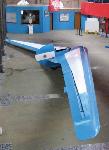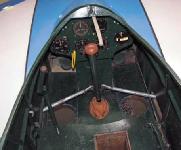Фотографии
-
The restoration of the IAe.34m took five years of concerted effort from the dedicated team of volunteers at the Industrial Museum at Cordoba. It was completed in the original pale blue and white colours of the original Clen Antus in late 2006 and is still on public display at the museum.
Самолёты на фотографии: FMA IAe.34 Clen Antu - Аргентина - 1949
-
One of the two IAe.34m single-seaters in flight. Reimar Horten himself referred to the two-seat variant as the H.XVa and the single-seaters as H.XVbs. Horten also developed the H.XVc (IAe.41), a side-by-side two-seat flyingwing glider, named Urubu (Owl), which first flew in 1953 and made a towed crossing of the Andes in 1956.
Самолёты на фотографии: FMA IAe.34 Clen Antu - Аргентина - 1949
-
One of the two single-seat IAe.34m ‘‘Sun Ray" flying-wing gliders built by Reimar Horten’s group of designers and engineers in Argentina in the 1950s. Although Horten had been experimenting with tailless designs for decades, the flying-wing concept was still problematic and the Sun Rays proved difficult to fly well.
Самолёты на фотографии: FMA IAe.34 Clen Antu - Аргентина - 1949
-
One of the two-seat IAe.34 Clen Antus under construction at Cordoba. The high-aspect-ratio wing was swept approximately 23° at quarter-chord with 3-5° dihedral. Yaw control was by means of the rudder pedals, which activated spoilers, located close to the wingtips, which could be used either differentially or together.
Самолёты на фотографии: FMA IAe.34 Clen Antu - Аргентина - 1949
-
To improve the aircraft’s low-speed handling characteristics, the first IAe.34 prototype was modified with an additional lifting surface mounted just aft of and below the trailing edge, as seen here, following which it was redesignated as the IAe.34B.
Самолёты на фотографии: FMA IAe.34 Clen Antu - Аргентина - 1949
-
The startlingly futuristic two-seat IAe.34 at Cordoba. The undercarriage consisted of a sprung front skid with rubber blocks which curved under the fuselage pod, where a pair of tandem wheels with mechanical brakes was fitted.
Самолёты на фотографии: FMA IAe.34 Clen Antu - Аргентина - 1949
-
The IAe.34 No 1 beside the Instituto Argentine) de Vuelo a Vela hangar.
Самолёты на фотографии: FMA IAe.34 Clen Antu - Аргентина - 1949
-
A Clen Antu in flight following the type’s maiden flight on June 20, 1949. It was not easy to fly. Pilot Manuel Fentanes recalls a flight in which he had difficulty in lowering the nose to see the tug. “I was careless and had taken the glider too high. Trying to track the tug aircraft I was using the pedals, and almost made the tug stall”.
Самолёты на фотографии: FMA IAe.34 Clen Antu - Аргентина - 1949
-
Регистрационный номер: LV-XXB The first single-seat IAe.34m, LV-XXB, at the World Gliding Championships in Spain in June 1952. All Clen Antus were originally painted in the Argentinian national colours of pale blue and white, with the Sol de Mayo emblem on the rear of the pod.
Самолёты на фотографии: FMA IAe.34 Clen Antu - Аргентина - 1949
-
The simple cockpit of the restored second IAe.34m, with the six basic flying instruments on the panel. Note the rather primitive control system incorporating rods connected directly to the control column, and the airbrake-operating pedals.
Самолёты на фотографии: FMA IAe.34 Clen Antu - Аргентина - 1949
-
The second IAe.34m during its painstaking restoration for static display at the Museo de la Industria Brigadier Mayor Juan San Martin in Cordoba.
Самолёты на фотографии: FMA IAe.34 Clen Antu - Аргентина - 1949
-
Still showing remnants of the red, white and pale blue scheme in which it was painted in 1962, the second IAe.34m was placed in storage until 2000.
Самолёты на фотографии: FMA IAe.34 Clen Antu - Аргентина - 1949
Статьи
- -
- A.Harris - Under Development
- A.Waller - A Flying Safari
- B.Hales-Dutton - A Day of Triumph and Tragedy
- B.Lindwall - Mosquito vs Bull: Fliying the J 30 in Flygvapnet service
- D.Menzies - "A Very Audible Remark..."
- E.Brown - Big Cat Diary
- F.Merriam - Early Days at Eastchurch /Echoes from Dawn Skies/ (1)
- G.Alegi - Secondo's Slow Burner: Campini, Caproni and the C.C.2
- G.Ellis - Hunting the Lion of Afrika
- G.Skillen - Terminal Velocity
- H.Carter - Fit for the King
- J.Forsgren - Sweden's midnight Mosquitoes
- P.Davidson - Off the Beaten Track...
- P.Jarrett - Lost & Found
- R.Lezon - Reimar's little Ray of Sunshine
- R.Simpson - Elegant Imperfection
- R.Tisdale, A.Vercamer - Before & After











